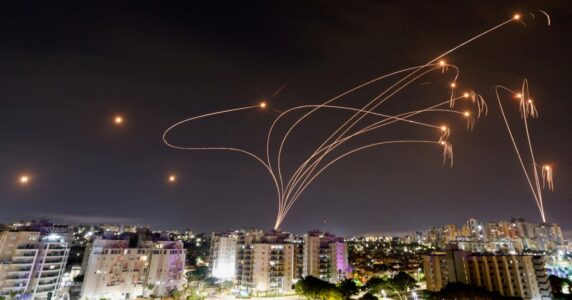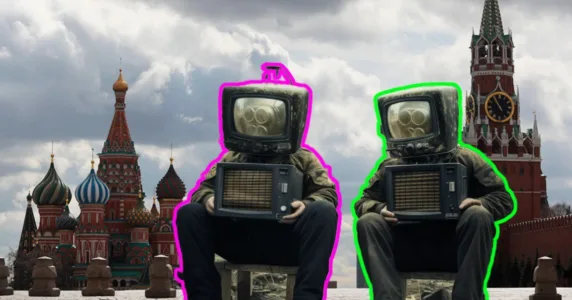Navigation and useful materials
Russian propaganda is once again trying to intimidate Ukrainians with the threat of hunger. Since the beginning of March, reports that the harvest of 2023 will be catastrophically low, and it will not suffice even for domestic needs, are spreading on social networks and Telegram channels.
The Centre for Strategic Communication and Information Security explains the essence of Russian manipulations on the topic of food security.
What is Used to Scare Ukrainians this time?
On Telegram, TikTok, and other social networks, an excerpt from the interview with Leonid Yakovyshyn, general director of LLC “Zemlia i Volia” (Land and Freedom), is posted. He talks about the difficulties Ukrainian farmers face during the full-scale war. In particular, about a significant increase in the price of ammonia fertilizers, the supplier of which was Russia.
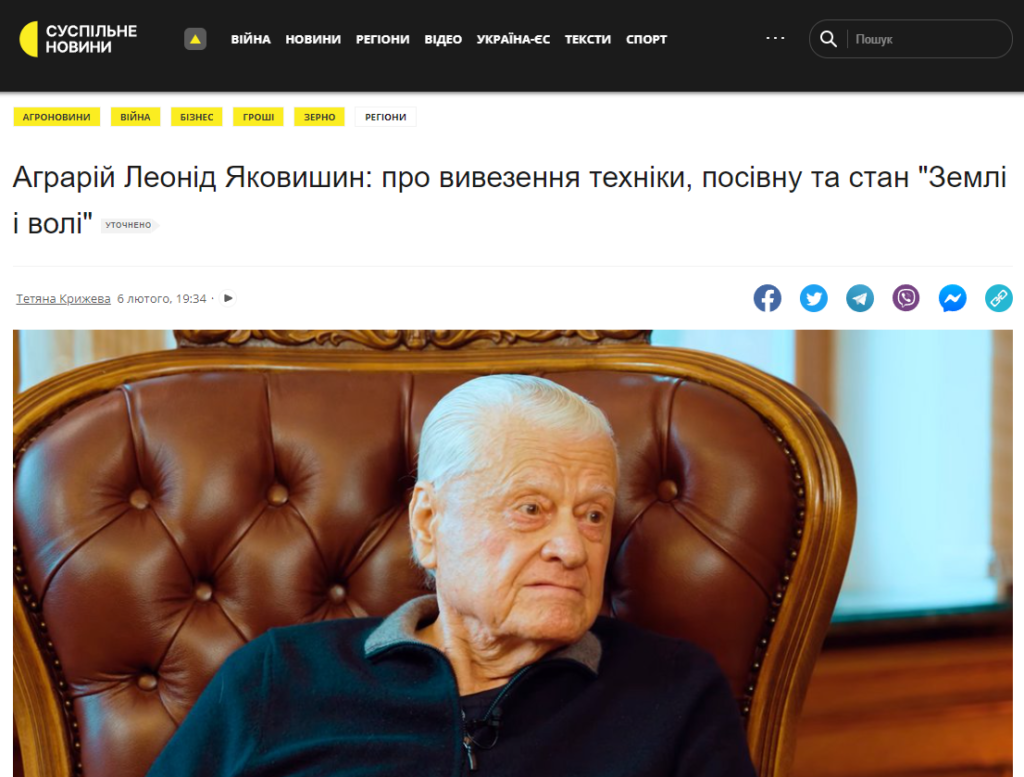
“Suspilne” published the interview on February 6. In three days, an excerpt with a manipulative video commentary by propagandist blogger Andrey Ponomarenko (Ponomar) and the caption “Ukrainians can face hunger in 2023 — farmers cannot sow” was first published on his social networks and uploaded to YouTube.
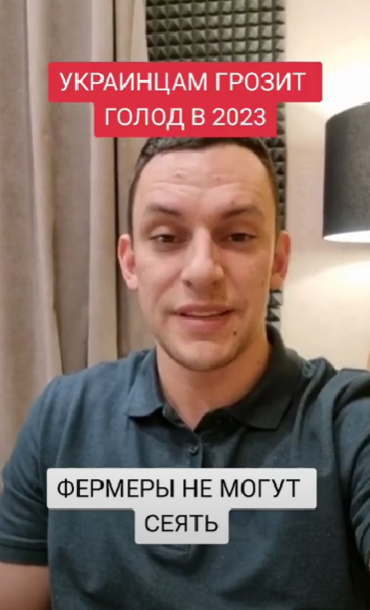
A month later, posts about the threat of famine in Ukraine due to the inaccessibility of fertilizers from Russia to Ukrainian farmers were simultaneously published by about 30 Telegram channels. Russian military correspondents and other propagandists, former Ukrainian politicians Volodymyr Oliinyk from the Party of Regions and Communist Spiridon Kilinkarov (both live in Moscow since 2014) and a network of pseudo-Ukrainian channels joined the spread of the narrative.
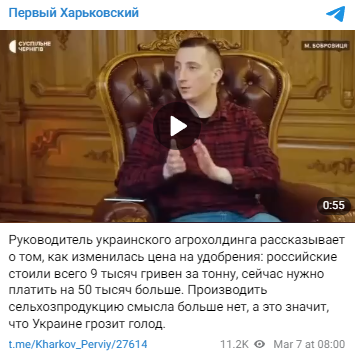

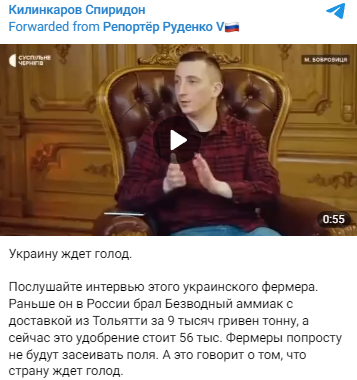
At the same time, the video began to be actively promoted on TikTok.
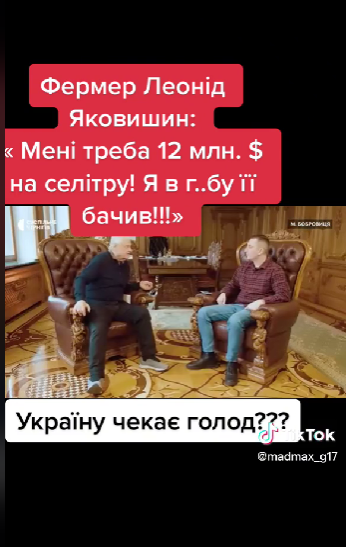
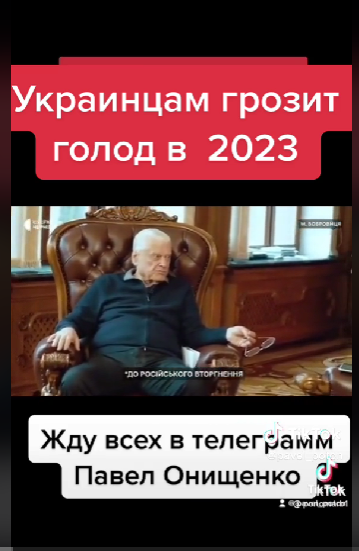
Another “political immigrant,” Pavlo Onyshchenko, who is also hiding from Ukrainian justice in Russia, not only posted a video of Ponomarenko, but also recorded his own microblog about the “planned famine.”

In fact, Leonid Yakovyshyn not only complains about the rise in price of ammonium nitrate, but also shares plans for growing sunflower, soybeans, barley, and winter wheat.
The words of the entrepreneur coincide with the forecasts of the Ministry of Agrarian Policy and Food of Ukraine for 2023. According to them:
● due to the rise in price of ammonia fertilizers, farmers partially reorient to oilseeds (sunflower, soybeans, rapeseed), the market value of which is at least twice higher than grain;
● most of the harvest of oilseeds, as in previous years, will be exported;
● the volume of harvest in 2023 may decrease by 10-15% due, in particular, to the lower yield of oilseeds compared to grain crop.
Therefore, Ukraine is not in danger of famine. Domestic needs before the full-scale invasion amounted to about 5 million tons of high-quality wheat (for the production of bread and other products), 500,000 tons of rye and 3.5 tons of fodder wheat (to feed livestock). In 2022, Ukrainian farmers harvested 41.9 million tons of grain and legume, including 19.4 million tons of wheat. Even with a reduction in crop volumes, there will be more than necessary harvest to meet the domestic demand. After all, the Ukrainian agricultural sector is export-oriented: many times more products are sold abroad than in Ukraine.
How Do Russians Intimidate Ukrainians and the World with Hunger?
Russia traditionally uses all the resources, the influence on the distribution of which it has in the world, as a weapon, and this is not the first time it blackmails the world community with the threat of hunger.
Having launched a full-scale invasion in 2022, the Russians blocked the Black Sea ports of Ukraine and, accordingly, the export of Ukrainian grain. Because of the Kremlin’s actions, the countries of Africa and the Middle East faced a real threat of famine.
In the end, the long consultations mediated by the UN ended with the conclusion of “grain deals.” On July 22, in Istanbul, Ukraine, Turkey, and the United Nations signed an agreement on security guarantees for exporters. The identical document with Turkey and the UN was signed by Russia. But even taking on clear obligations, the Russians tried to slow down the implementation of the deals and looked for a reason to block the “grain corridor.” At the same time, the Kremlin cynically accused Ukraine of provoking a global food crisis. This message was especially actively promoted in the countries of the Global South, which import Ukrainian food.
Russian propagandists did not forget about the Ukrainian audience, trying to use the collective memory of the Holodomor, photos and videos of burning fields, as well as reports of their mining and stealing of crops. To discredit the “grain deals” and the government that signed them, a message was spread that “all the bread will be taken out of Ukraine — the Ukrainians will have nothing to eat.” It was distributed by the already mentioned “Ponomar.”

In fact, the unblocking of grain exports allowed Ukrainian farmers to receive funds and sow. After all, most of the harvest was intended for sale in foreign markets. And had it remained in Ukraine, it would have been a devastating blow both for the agricultural sector and for the Ukrainian economy as a whole.
By promoting conspiracy and blatantly false “forecasts” about the “planned famine,” Russian propaganda is trying to demoralize Ukrainians, further increase the level of anxiety in the context of the war, and discredit the Ukrainian authorities and business at a time when acute food problems happen precisely in those territories that were occupied or destroyed by the Russians.
Centre for Strategic Communication and Information Security
If you have found a spelling error, please, notify us by selecting that text and pressing Ctrl+Enter.
